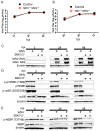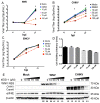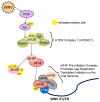4EBP-Dependent Signaling Supports West Nile Virus Growth and Protein Expression
- PMID: 27763553
- PMCID: PMC5086619
- DOI: 10.3390/v8100287
4EBP-Dependent Signaling Supports West Nile Virus Growth and Protein Expression
Abstract
West Nile virus (WNV) is a (+) sense, single-stranded RNA virus in the Flavivirus genus. WNV RNA possesses an m7GpppNm 5' cap with 2'-O-methylation that mimics host mRNAs preventing innate immune detection and allowing the virus to translate its RNA genome through the utilization of cap-dependent translation initiation effectors in a wide variety of host species. Our prior work established the requirement of the host mammalian target of rapamycin complex 1 (mTORC1) for optimal WNV growth and protein expression; yet, the roles of the downstream effectors of mTORC1 in WNV translation are unknown. In this study, we utilize gene deletion mutants in the ribosomal protein kinase called S6 kinase (S6K) and eukaryotic translation initiation factor 4E-binding protein (4EBP) pathways downstream of mTORC1 to define the role of mTOR-dependent translation initiation signals in WNV gene expression and growth. We now show that WNV growth and protein expression are dependent on mTORC1 mediated-regulation of the eukaryotic translation initiation factor 4E-binding protein/eukaryotic translation initiation factor 4E-binding protein (4EBP/eIF4E) interaction and eukaryotic initiation factor 4F (eIF4F) complex formation to support viral growth and viral protein expression. We also show that the canonical signals of mTORC1 activation including ribosomal protein s6 (rpS6) and S6K phosphorylation are not required for WNV growth in these same conditions. Our data suggest that the mTORC1/4EBP/eIF4E signaling axis is activated to support the translation of the WNV genome.
Keywords: RNA; West Nile virus; protein synthesis; translation.
Conflict of interest statement
The authors declare no conflict of interest.
Figures








Similar articles
-
West nile virus-induced activation of mammalian target of rapamycin complex 1 supports viral growth and viral protein expression.J Virol. 2014 Aug;88(16):9458-71. doi: 10.1128/JVI.01323-14. Epub 2014 Jun 11. J Virol. 2014. PMID: 24920798 Free PMC article.
-
Phosphorylation of eukaryotic translation initiation factor 4E and eukaryotic translation initiation factor 4E-binding protein (4EBP) and their upstream signaling components undergo diurnal oscillation in the mouse hippocampus: implications for memory persistence.J Biol Chem. 2014 Jul 18;289(29):20129-38. doi: 10.1074/jbc.M114.552638. Epub 2014 Jun 3. J Biol Chem. 2014. PMID: 24895127 Free PMC article.
-
Inhibition of insulin signaling and adipogenesis by rapamycin: effect on phosphorylation of p70 S6 kinase vs eIF4E-BP1.Int J Obes Relat Metab Disord. 2004 Feb;28(2):191-8. doi: 10.1038/sj.ijo.0802554. Int J Obes Relat Metab Disord. 2004. PMID: 14970836
-
Manipulation of the host translation initiation complex eIF4F by DNA viruses.Biochem Soc Trans. 2010 Dec;38(6):1511-6. doi: 10.1042/BST0381511. Biochem Soc Trans. 2010. PMID: 21118117 Review.
-
Replication cycle and molecular biology of the West Nile virus.Viruses. 2013 Dec 27;6(1):13-53. doi: 10.3390/v6010013. Viruses. 2013. PMID: 24378320 Free PMC article. Review.
Cited by
-
Pathogens MenTORing Macrophages and Dendritic Cells: Manipulation of mTOR and Cellular Metabolism to Promote Immune Escape.Cells. 2020 Jan 9;9(1):161. doi: 10.3390/cells9010161. Cells. 2020. PMID: 31936570 Free PMC article. Review.
-
AMPK protects endothelial cells against HSV-1 replication via inhibition of mTORC1 and ACC1.Microbiol Spectr. 2023 Sep 13;11(5):e0041723. doi: 10.1128/spectrum.00417-23. Online ahead of print. Microbiol Spectr. 2023. PMID: 37702499 Free PMC article.
-
The Mechanistic Target of Rapamycin (mTOR): Novel Considerations as an Antiviral Treatment.Curr Neurovasc Res. 2020;17(3):332-337. doi: 10.2174/1567202617666200425205122. Curr Neurovasc Res. 2020. PMID: 32334502 Free PMC article. Review.
-
Insulin-mediated endothelin signaling is antiviral during West Nile virus infection.bioRxiv [Preprint]. 2023 Jan 18:2023.01.17.524426. doi: 10.1101/2023.01.17.524426. bioRxiv. 2023. Update in: J Virol. 2023 Oct 31;97(10):e0111223. doi: 10.1128/jvi.01112-23. PMID: 36712090 Free PMC article. Updated. Preprint.
-
COVID-19 and diabetes mellitus: how one pandemic worsens the other.Rev Endocr Metab Disord. 2020 Dec;21(4):451-463. doi: 10.1007/s11154-020-09573-6. Rev Endocr Metab Disord. 2020. PMID: 32743793 Free PMC article. Review.
References
-
- Szretter K.J., Daniels B.P., Cho H., Gainey M.D., Yokoyama W.M., Gale M., Jr., Virgin H.W., Klein R.S., Sen G.C., Diamond M.S. 2′-O methylation of the viral mRNA cap by West Nile virus evades IFIT1-dependent and -independent mechanisms of host restriction in vivo. PLoS Pathog. 2012;8:287. doi: 10.1371/journal.ppat.1002698. - DOI - PMC - PubMed
MeSH terms
Substances
Grants and funding
LinkOut - more resources
Full Text Sources
Other Literature Sources
Miscellaneous

